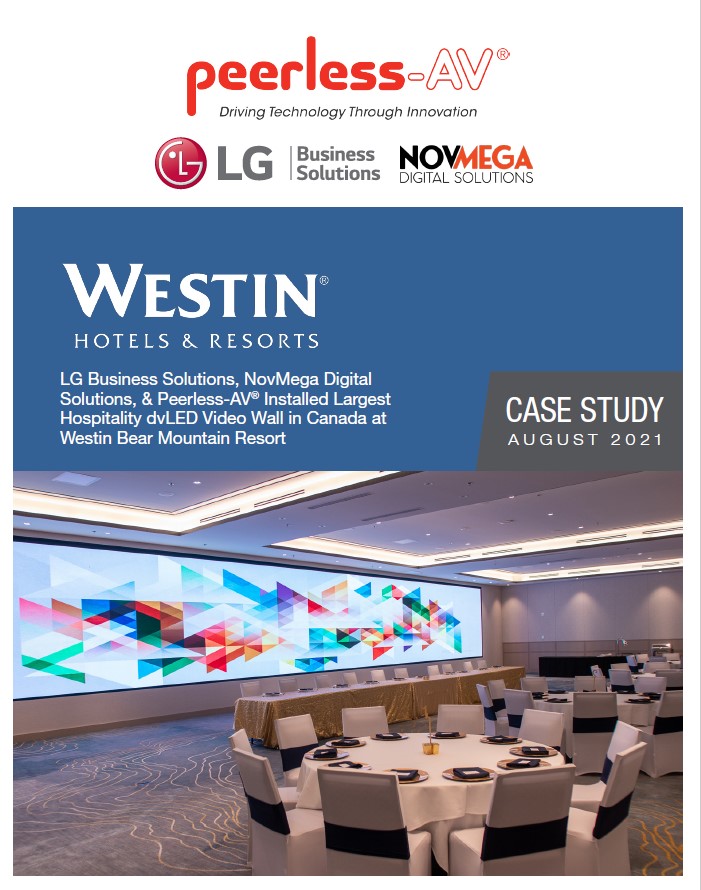Five Ways Hospitality Brands Can Benefit from Audiovisual Technologies
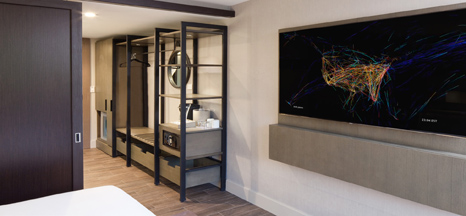
Have you stayed in a hotel or eaten in a theme restaurant lately? If so, you couldn’t help but notice large video screens stationed everywhere from entrance lobbies to hallways and from bars to patios. Or maybe you heard music coming from rocks along the path to the pool. Arrived early? A text message probably came to your phone to let you know when your table or room was ready. A similar text message from your phone got you checked out, and your restaurant tab might have come to you via email.
The hospitality industry has raised its game considerably over the past decade. Whether it’s touchscreen kiosks for checking in, smartphone apps for controlling room functions, or wireless tablets for ordering food, hotels, resorts, restaurants, and clubs have gotten a lot “smarter” and more “connected.”
In-room televisions have evolved from old, bulky tube models to large LCD and OLED screens. In some hotels, guests can operate a variety of devices from their phones, including shades and thermostats. Wi-Fi is ubiquitous; so is access to streaming video. Large open spaces such as lobbies are transformed in minutes to glitzy nightclubs or even faux city streets. And touchscreens are everywhere, providing daily schedules and property maps as well as booking reservations and excursions.
Hotels and restaurants have vigorously embraced AV technology, and not just to show off. Today’s guests are as concerned about “going green” as they are about having a great meal or vacation. Cutting-edge AV installations are often integrated with the hotel or restaurant’s local area network, serving AV content to and controlling multiple displays, speakers, lighting, and shades. And it’s all being done in a way that is unobtrusive; blending in with greenery, fountains and patios, drapes, and other interior and exterior decorations.
In this paper, we’ll look at five different ways that hotels, resorts, and restaurants can put the newest generation of audiovisual technology to work and better engage customers.
#1 Integrate AV to Transform Open Spaces
_web.jpg?sfvrsn=d67f15d_0) Hotel lobbies are usually large open spaces with seats scattered here and there, opening into elevator lobbies, restaurants, and bars. Most of them look the same way at night as they do in the day time — lots of wood décor, area lighting, plants here and there, and perhaps a fountain or fireplace near some comfortable chairs. In short, lobbies are a place to travel through on the way to somewhere else, not destinations.
Hotel lobbies are usually large open spaces with seats scattered here and there, opening into elevator lobbies, restaurants, and bars. Most of them look the same way at night as they do in the day time — lots of wood décor, area lighting, plants here and there, and perhaps a fountain or fireplace near some comfortable chairs. In short, lobbies are a place to travel through on the way to somewhere else, not destinations.
That might be fine for daytime, but how about transforming the space for evening hours? The W Hotel in New York City is situated just a few blocks from the bustle and dazzle of Times Square. The main lobby, which is up a floor from street level, has a spacious and green feel to it. While that ambiance is fine during the day, management wanted to make the main lobby an exciting destination unto itself — and they didn’t have to look far for inspiration.
They wound up creating a space that is styled as a tribute to Times Square, offering a lively atmosphere that shifts from daytime to parties with a custom DJ booth.
As the lobby transforms into a destination where guests and locals can interact, the hotel bar becomes part of the front desk. Neon lighting, vibrant signs, and graffiti were custom-designed for the space: A digital countdown clock almost seven feet tall takes up a wall, while sound from 32 independent zones and hidden custom speakers fill the transformed space with sound.
The lounge has its own digital brain, capable of shifting its atmosphere for different guests and events. Using a touchscreen, W Hotel staff can activate and adjust every light and speaker to produce the right atmosphere from a selection of presets. Guests in each private booth have control over their own audio zone, so they can pump up the music from the custom New Year’s Eve Ball-inspired DJ booth or turn it down for a quiet conversation.
#2 Adopt the Internet of Things (IoT) to Guest Rooms
_web.jpg?sfvrsn=130b678d_0) The concept of room control has evolved from complex wired systems with limited functionality to app-based designs that run on mobile devices and can even respond to voice commands. The increasing popularity of Siri, Alexa, and Google Assistant voice recognition systems in the home means that travelers of all ages — Gen Ys to baby boomers — are receptive to having the same level of control in thier hotel room. In fact, many expect they’ll be able to operate lights, shades, and thermostats just as easily as they do at home from a smartphone or tablet.
The concept of room control has evolved from complex wired systems with limited functionality to app-based designs that run on mobile devices and can even respond to voice commands. The increasing popularity of Siri, Alexa, and Google Assistant voice recognition systems in the home means that travelers of all ages — Gen Ys to baby boomers — are receptive to having the same level of control in thier hotel room. In fact, many expect they’ll be able to operate lights, shades, and thermostats just as easily as they do at home from a smartphone or tablet.
The 1 Hotel near the Brooklyn Bridge was constructed with this in mind. The property features work from local artisans, offers complimentary electric vehicle and bicycle valet service, and décor with sustainable materials such as reclaimed wood, hemp, and organic cotton. Hidden behind the hotel interior is the latest in automation, audiovisual, communications, and energy management in all the guestrooms, as well as public spaces, ballrooms, and the rooftop pool deck.
Smart technology keeps the building running “green” and lets guests interact with lighting, shades, and temperature. To provide hotel management with a tool to track and improve sustainability, the automation system ties into a backend platform with energy statistics, keeping records on usage of lighting and climate control equipment in each room.
Lighting scenes incorporate multiple fixtures for easy control from a single keypad. A “Good Night” button sits beside the bed so guests can shut off all of the lights in the room with one button press. “Do Not Disturb” signs that once hung on door latches are now also electronic; guests can press a button to request privacy. A floor-to-ceiling window in each room opens to bring in fresh air and a sensor protects the room by automatically deactivating the air conditioning to conserve energy. If a storm is coming, the system can shut the window in preparation.
#3 Mix in Larger-Than-Life Digital Signs for Navigation
“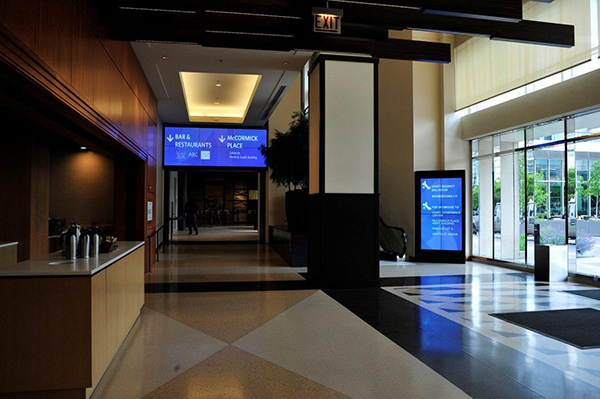 You can get there from here. Just follow these directions.” Concierges all across the globe have uttered these words more than once to disoriented visitors, offering up a photocopied map or hotel layout with hastily-drawn arrows on it to get those visitors where they need to go. But things change constantly — information about conventions, meeting room locations, and special events like street fairs, outdoor concerts, and sporting events must be updated daily and sometimes hourly. That’s a lot of scribbling and copying!
You can get there from here. Just follow these directions.” Concierges all across the globe have uttered these words more than once to disoriented visitors, offering up a photocopied map or hotel layout with hastily-drawn arrows on it to get those visitors where they need to go. But things change constantly — information about conventions, meeting room locations, and special events like street fairs, outdoor concerts, and sporting events must be updated daily and sometimes hourly. That’s a lot of scribbling and copying!
To solve this three-fold problem of cutting down on hastily-scrawled maps, providing accurate and timely directions, and making the signs large enough to be viewed at a distance, the Hyatt Regency McCormick Place decided to install clusters of large tiled electronic displays at key points in the lobby, in corridors, and at entrances and exits. The Hyatt sits adjacent to the McCormick Place convention center and sees large numbers of guests and visitors transiting between the two buildings.
In the first project phase, a 4x2 LCD video wall was installed behind the concierge desk and a 3x2 LCD video wall was mounted at the end of a ground floor hallway that leads to both restaurants and the connection to McCormick Place. Later on, a 2x3 LCD video wall was added at the opposite end of the ground floor hallway, while a 2x2 portrait orientation LCD video wall now sits at the base of an escalator leading to Hyatt meeting spaces. Optically-bonded glass fronts mitigate the possibility of damage or broken hardware, and the displays are sufficiently bright to overcome the vast amount of sunlight entering through the large windows on the south side of the building.
Beyond wayfinding, the video walls are also used for promotions, advertising and communications, such as signage packages for automotive manufacturers during an auto show or custom messaging that supports branding efforts for the Hyatt Regency’s local city partners. Aspirational content can also be featured, such as thanking servicemen and women on Veteran’s Day or highlighting a specific charity. All four walls are controlled and updated from a small rack behind the concierge desk.
#4 Make it Feel Like Home ... in a Hotel
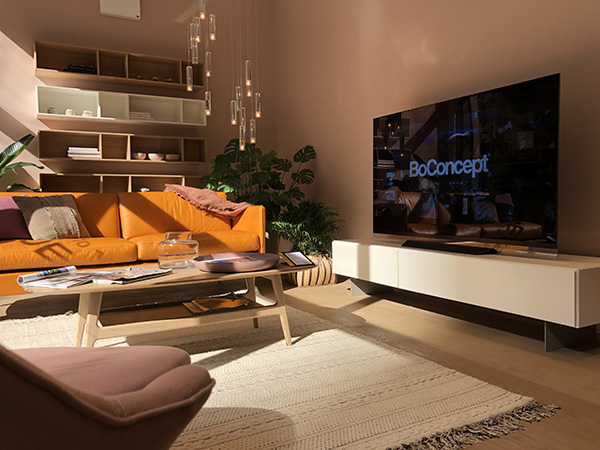 There is a clear trend with hotels to make the experience more like home — by creating inviting and familiar rooms and spaces. That can result in a complete renovation as the latest in AV technology is integrated across a wide range of spaces, including lobbies, meeting rooms, and fitness centers. Guests expect fast Wi-Fi connectivity and are just as happy watching video content from their mobile devices as they are on a room television. And when a group of guests gets together, there had better be some food and drink handy — but not necessarily a sit-down restaurant
There is a clear trend with hotels to make the experience more like home — by creating inviting and familiar rooms and spaces. That can result in a complete renovation as the latest in AV technology is integrated across a wide range of spaces, including lobbies, meeting rooms, and fitness centers. Guests expect fast Wi-Fi connectivity and are just as happy watching video content from their mobile devices as they are on a room television. And when a group of guests gets together, there had better be some food and drink handy — but not necessarily a sit-down restaurant
Marriott Hotels decided to update a 30-year-old property in Charlotte, North Carolina, into an inviting, flexible, and modern space. Each of the 444 guest rooms features a 55-inch LCD TV, serving as the hub for in-room information and entertainment. Hotel and local area information is at each guest’s fingertips right in the room, and the TVs allow guests to stream content from Netflix, Hulu, YouTube, and Pandora on their smart devices directly to the big screen.
Marriott also considered the needs of travelers who were looking for more flexible solutions to their workouts on the road. Existing fitness centers typically house limited, aging equipment and uninspiring spaces, forcing guests to bring their own mobile devices to studio spaces to stream content. Instead, Marriott installed a 3x3 video wall of 47-inch LCD displays and a soundbar in the newly renovated fitness center to show Fitness on Demand, which offers over 1,600 free classes.
At the check-in area, guests are able to use a touchscreen monitor to find their reservation, while a unique kitchen serves as a place to socialize. In addition to the very latest in kitchen appliances, multiple 55-inch OLED televisions provide entertainment. The impetus for this space? Marriott recognized that when friends get together, they will inevitably wind up in the kitchen. It’s proven to be more popular than the hotel bar.
#5 Redefine the Restaurant and Bar Space
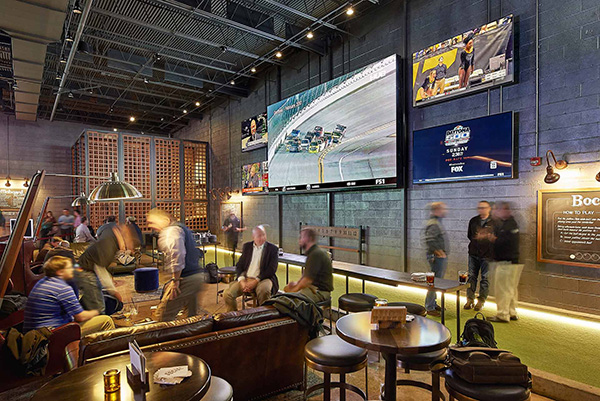 There are sports bars, and there are casual restaurants, and there are lounges and recreation rooms. Sports bars will usually install multiple large-screen televisions to provide live sports playback for guests, but it’s not always easy to see a given screen from a given seat. The high backs of booths can also block views, and woe to the guest whose favorite team only appears on a monitor in back of their seat. Adding more televisions and monitors increases complexity, so why not go with fewer but larger screens as a practical solution?
There are sports bars, and there are casual restaurants, and there are lounges and recreation rooms. Sports bars will usually install multiple large-screen televisions to provide live sports playback for guests, but it’s not always easy to see a given screen from a given seat. The high backs of booths can also block views, and woe to the guest whose favorite team only appears on a monitor in back of their seat. Adding more televisions and monitors increases complexity, so why not go with fewer but larger screens as a practical solution?
That’s what Lodging Hospitality Management did when it opened The Westport Social, a 13,000-square-foot classic bar and gaming lounge packed with amenities and entertainment. This space combines traditional restaurant and bar seating with two private karaoke rooms, an outdoor patio, and a spacious interior teeming with a diversity of games such as ping-pong, pop-a-shot basketball, and foosball.
The main bar is in a large open room with 20-foot ceilings that offers booths and lounge-style seating. The décor of wood and black warehouse-style ducting and lighting fixtures is combined with three 16-foot-long, 9-foot-high LED video walls with a fine 1.8mm pixel pitch. Each LED wall is complemented by four additional smaller widescreen video displays, featuring alternate channels. Patrons have a total of 15 different screens to watch live sports while enjoying food and drink. Regulation bocce and shuffleboard courts sit directly under the LED walls on two sides of the space.
Fine-pitch indoor LED displays are rapidly gaining popularity for similar venues. Their bright, contrast-y images hold up well under full house lighting and the fine pixel pitch is equivalent to that of a large 4K television, even when viewed close-up. As elaborate as the Westport Social installation appears, each one of the 15 displays can be controlled by any employee using nothing more than an iPad interface. The morning shift can push one button to turn everything on, as well as change channels and switch from a single screen to a quad view.



